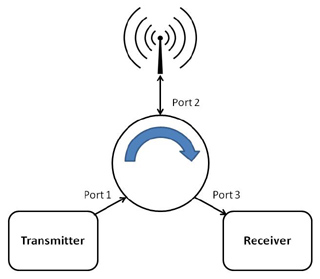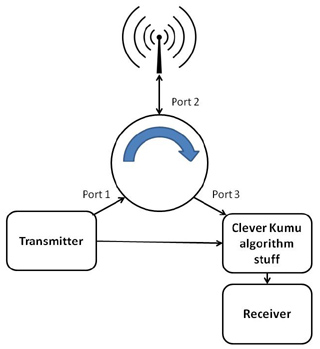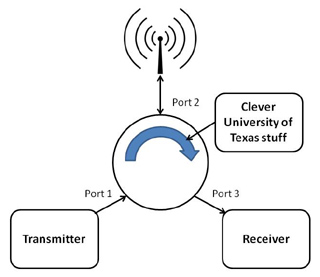Does full duplex equal double the capacity?
So far, at least two organisations have developed technologies which theoretically allow a radio transceiver to transmit AND receive on the same frequency at the same time. Such ‘full duplex’ technologies are becoming all the rage because in theory it means that each and every frequency could be used twice – once to receive and once to transmit – without the radio transceiver interfering with itself.

The two principles being proposed both rely on the use of a circulator, but do so in different ways. A circulator has a number of ports (typically 3 or 4). A signal applied to one port will only exit the ‘next’ port in the sequence. So for a 3 port circulator, signals applied to port 1 will only exit port 2. Signals applied to port 2 will only exit port 3, and so forth. As such, if you connect a transmitter to port 1, an antenna to port 2 and a receiver to port 3, the transmit signal should not enter the receiver.
The problem is that current circulators are not perfect and though, in theory, none of the signal from the transmitter on port 1 should end up in the receiver at port 3, there is a certain amount of ‘leakage’. A received signal might be 12 orders of magnitude (a million-millionth) smaller than the signal from the transmitter so even if the circulator could prevent a 99.9999% of the transmitted signal getting to the receiver, the interference caused by the transmitter would still be a million times stronger than the signal that was trying to be received.

The solution proposed by Kumu Networks takes a ‘sniff’ of the transmitted signal and then looks at the signal coming from the circulator to the receiver. As it knows exactly what the transmitted signal looks like, it can use signal processing algorithms to further reduce the effect of the transmitted signal thereby nulling it and allowing the received signal through.

The solution proposed by the University of Texas ‘tunes’ the circulator to improve its performance sufficiently to reduce the transmitted signal far enough to allow the receiver to operate.
There are concerns that these techinques may use a lot of power which, if they are to be implemented in mobile, battery powered, devices, is not a good start. However, like all technologies, unless there is some fundamental, physical reason that they need high power (such as needing ultra-linear class-A radio frequency amplifiers) it can be assumed that the power requirements will fall as the technique is developed.
But there seems to be a far more fundamental flaw in the whole idea of full-duplex, single-frequency operation (i.e. transmitting and receiving on the same frequency). Take a base station. If it could receive on the same frequency on which it was transmitting, what would it hear? Why, all of the other base stations which were sharing the same frequency, of course. And all of them would produce a much stronger unwanted signal than the tiny mobile handset that it would ideally like to hear. And it’s not possible to cancel the interference that other base stations would cause because of the constant variability of radio propagation between sites and thus the unpredictability of the interference they would cause.
What about at the mobile handset? If it could listen on the frequency it was transmitting on, it would hear any other nearby mobile handsets. Hardly a compelling benefit!
The real benefit of these technologies might be to reduce the ‘duplex’ gaps that are currently necessary between the transmit and receive frequencies used by most mobile networks. Such networks use a ‘pair’ of frequencies, on one which the base-station transmits, and one on which the mobile handsets transmit. Between them is a gap which is there to prevent the base-stations from receiving interference from their own transmitters on immediately adjacent frequencies. Likewise the gap does the same job at the mobile handset end. If it were possible to cancel out the impact of the transmitters, this duplex gap that could be removed.

As examples, the 900 MHz mobile band runs from 880 – 960 MHz (80 MHz) but has a duplex gap from 915 – 925 MHz (10 MHz) so if the gap could be filled, it would increase spectrum availability by 12.5% (though some of this gap is in use for other purposes). The 1800 MHz band runs from 1710 – 1880 MHz (170 MHz) but has a duplex gap from 1785 – 1805 MHz (20 MHz). Filling the gap would again increase spectrum availability by around 12%. Similar patterns are found in other paired mobile bands.
So rather than the bold claim that full-duplex operation increases spectrum availability by 100%, or doubles capacity, a more modest claim that would allow duplex gaps to be gotten rid of and thus increase spectrum availability by nearer 12% might, just, be justified.